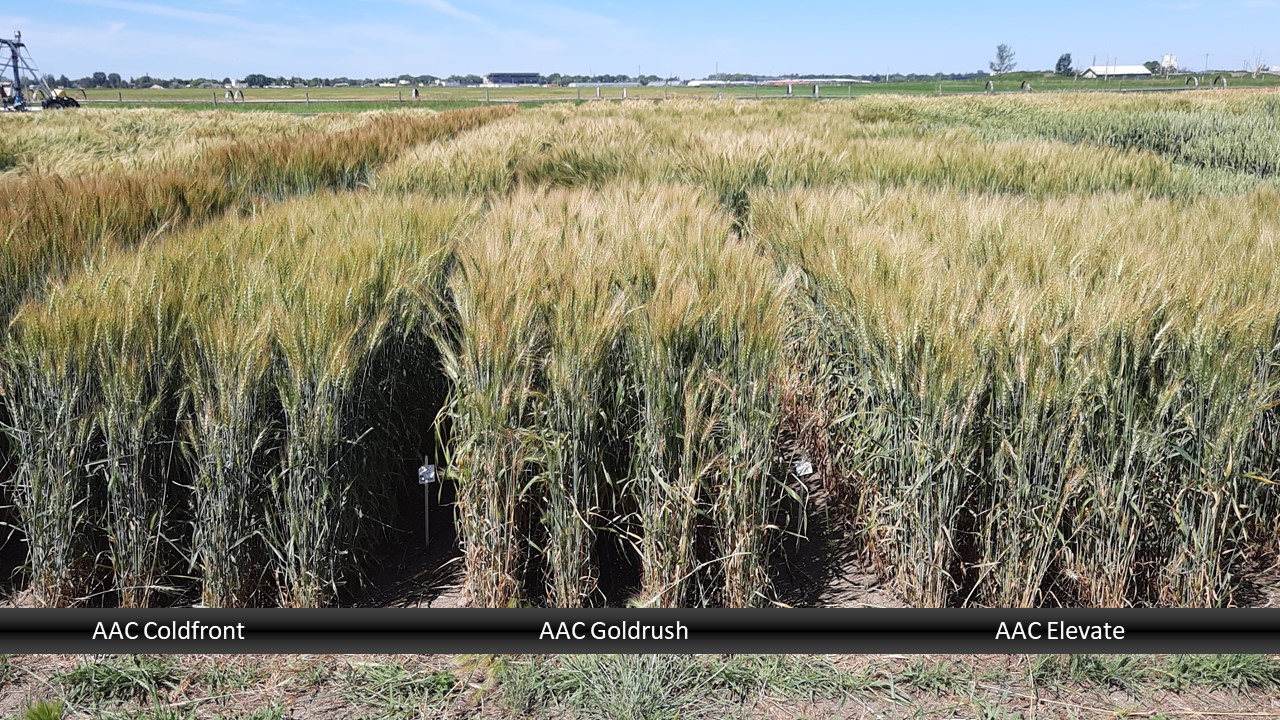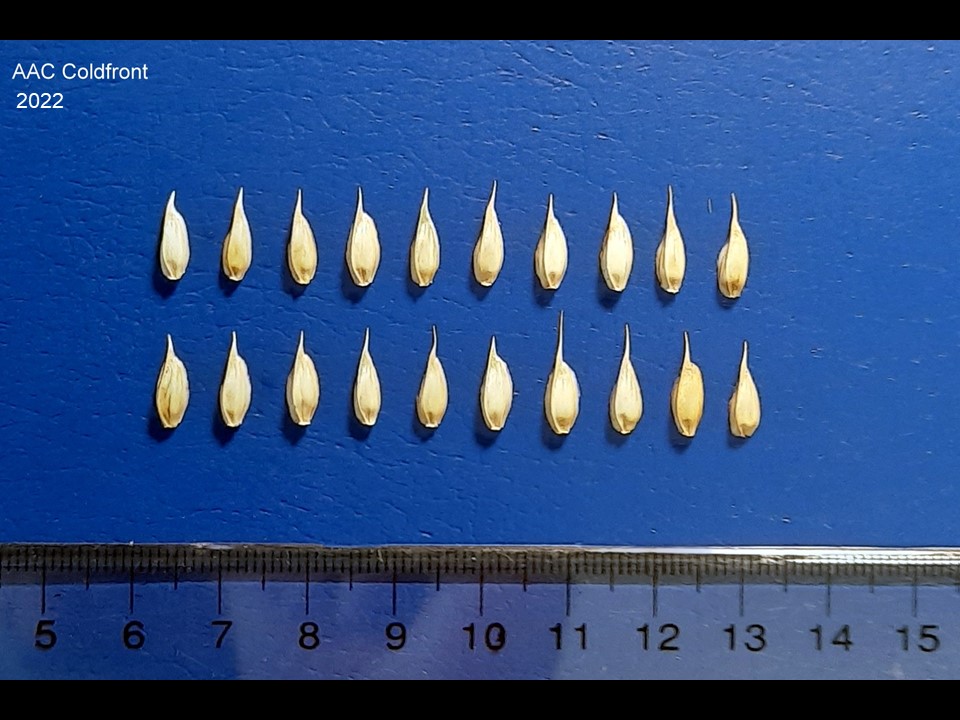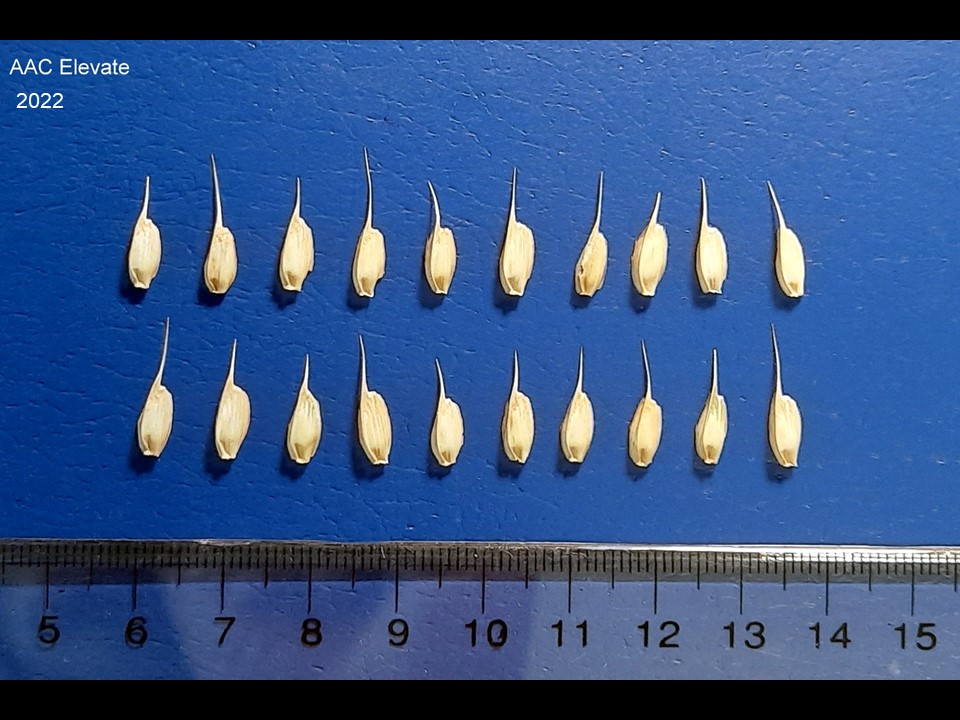AAC Coldfront
| Denomination: | 'AAC Coldfront' |
|---|---|
| Botanical Name: | Triticum aestivum |
| Applicant/Holder: |
Agriculture & Agri-Food Canada, Lethbridge Lethbridge Research Centre, 5403 - 1 Avenue, South P.O. Box 3000 Lethbridge, Alberta T1J 4B1 Canada |
| Breeder: |
Robert Graf, Agriculture & Agri-Food Canada, Lethbridge, Alberta |
| Agent in Canada: |
Agriculture & Agri-Food Canada Office of Intellectual Property and Commercialization c/o Shannon Whyte 107 Science Place Saskatoon, Saskatchewan S7N 0X2 Canada Tel: (204) 999-9887 |
| Application Date: | 2022-01-12 |
| Provisional Protection:: | 2022-01-12 |
| Application Number: | 22-10774 |
| Grant of Rights Date: | 2023-08-02 |
| Certificate Number: | 6853 |
| Grant of Rights Termination Date: | 2043-08-02 |
Variety Description
Varieties used for comparison: 'AAC Goldrush' and 'AAC Elevate'
Summary: At the 5 to 9 tiller stage, the plants of 'AAC Coldfront' have a prostrate growth habit while the plants of 'AAC Elevate' have an intermediate to semi-prostrate growth habit. At heading, the degree of glaucosity on the flag leaf sheath of 'AAC Coldfront' is strong whereas it is medium for that of the reference varieties. At anthesis, the blade of the flag leaf is glabrous for 'AAC Coldfront' whereas it is pubescent for that of 'AAC Elevate'. The flag leaf of 'AAC Coldfront' is narrower than that of the reference varieties. The plants of 'AAC Coldfront' head earlier than the plants of the reference varieties. At maturity, the plants, including the spike and awns, of 'AAC Coldfront' are shorter than the plants of 'AAC Goldrush'. The spike, excluding the awns, of 'AAC Coldfront' is longer than that of the reference varieties. The lower glume shoulder of 'AAC Coldfront' is absent or very narrow and strongly sloping whereas the lower glume shoulder of 'AAC Elevate' is of medium width and straight. The thousand kernel weight of 'AAC Coldfront' is less than that of 'AAC Elevate'.
Description:
PLANT: winter type, common wheat, prostrate growth habit at 5 to 9 tiller stage, absent or very low to low frequency of plants with recurved flag leaves, heads early in season, matures mid-season
SEEDLING (4-LEAF STAGE): glabrous sheath and lower leaf blade
FLAG LEAF: absent or very weak intensity of anthocyanin colouration of auricles, strong glaucosity of sheath at heading, glabrous sheath and blade at anthesis
CULM: medium to strong glaucosity at anthesis, straight to very weakly curved neck at maturity
STRAW (AT MATURITY): pith very thin in cross-section, anthocyanin colouration absent
SPIKE: medium glaucosity at heading, tapering shape in profile, medium density, erect to inclined attitude, white to yellow at maturity
AWNS: shorter than to equal to spike, white to light yellow at maturity
LOWER GLUME: medium length, medium width, glabrous
LOWER GLUME SHOULDER: strongly sloping, absent or very narrow
LOWER GLUME BEAK: short to medium length
KERNEL: hard red type, medium red
AGRONOMIC TRAITS: very good lodging resistance, good winter survival
BREAD MAKING QUALITY: good
DISEASE REACTIONS: resistant to Leaf rust (Puccinia triticina), Stem rust (Puccinia graminis) and Stripe rust (Puccinia striiformis); moderately resistant to moderately susceptible to Fusarium head blight (Fusarium graminearum), susceptible to Common bunt (Tilletia tritici and Tilletia laevis)
INSECT REACTION: susceptible to Wheat Curl Mite (Aceria tosichella)
Origin & Breeding History: 'AAC Coldfront' (experimental designation 'W601') originated from the three way cross between the F1 of 'Norstar' and 'CDC Falcon' and LF1318, which was completed at Agriculture and Agri-Food Canada, Lethbridge Research and Development Centre in Lethbridge, Alberta in 2008. Following the growth of F1 plants in a greenhouse in 2009, 138 spikes were selected in 2010 from an F2 bulk plot grown in a field in Lethbridge. In 2011, several hundred spikes were selected from F3 rows based on winter survival, spring vigour, plant type, height, straw strength and stripe rust resistance. In 2012, selected spikes were threshed in bulk and grown as F4 bulk plots in Saskatoon where 153 spikes were selected based on winter survival, plant type, height and straw strength. The seeds from the individually threshed spikes were then planted as F5 rows in fall 2012 to assess stem and leaf rust resistance in an inoculated nursery at the University of Manitoba campus in Winnipeg in 2013. Spikes were selected from the rows expressing stem and leaf rust resistance and planted as F6 head rows in Lethbridge. In 2014, 40 rows were harvested and then seeded in single replicate preliminary trials, a screening nursery for stripe rust and in controlled conditions to screen for wheat curl mite resistance in Lethbridge and in screening nurseries for stem and leaf rust in Winnipeg. From 2016 to 2017, line selections were made based on yield and production characteristics, disease resistance and end use quality. The line designated LR535 in fall 2014 was entered into the Western Canadian Winter Wheat Cooperative registration trials as 'W601' in the fall 2017 where it was evaluated from 2018 to 2020 at multiple locations. Breeder seed was produced using a head-row derivation approach. Spikes were randomly selected from a rogued F11 increase plot, threshed individually and then grown and examined for two years prior to the bulking of 37 F13 breeder lines in 2021.
Tests & Trials: The comparative trials for 'AAC Coldfront' were conducted at Agriculture and Agri-Food Canada, Lethbridge Research and Development Centre in Lethbridge, Alberta in 2021 and 2022. The varieties in the trial were sown in the previous fall in late September. There were 3 replicates per variety arranged in an RCB design. Plots were 4.1 square metres, and consisted of 4 rows 3.5 metres in length with 0.23 metres between rows. Plots were spaced 0.54 metres apart. The seeding density was 360 seeds per square metre, resulting in approximately 4300 plants per variety per year. Measured characteristics were based on a minimum of 26 measurements per variety per year except for kernel weight which was based on 12 measurements per variety per year. Mean differences were significant at the 5% probability level based on Student's t-tests. Disease reaction ratings were provided through the disease evaluation of the Western Canadian Winter Wheat Cooperative Registration trials from 2018 to 2020.
Comparison tables for 'AAC Coldfront' with reference varieties 'AAC Goldrush' and 'AAC Elevate'
Flag leaf width (mm)
| 'AAC Coldfront' | 'AAC Goldrush' | 'AAC Elevate' | |
|---|---|---|---|
| mean 2021 | 10.7 | 11.6 | 11.2 |
| std. deviation 2021 | 0.8 | 1.2 | 0.9 |
| mean 2022 | 11.8 | 13.4 | 12.8 |
| std. deviation 2022 | 1.1 | 0.8 | 1.0 |
Days to heading (days from January 1 to when 50% heads are fully emerged from boot)
| 'AAC Coldfront' | 'AAC Goldrush' | 'AAC Elevate' | |
|---|---|---|---|
| mean 2021 | 160 | 163 | 162 |
| mean 2022 | 166 | 169 | 168 |
Plant height at maturity (including spike and awns) (cm)
| 'AAC Coldfront' | 'AAC Goldrush' | 'AAC Elevate' | |
|---|---|---|---|
| mean 2021 | 84.3 | 89.6 | 85.6 |
| std. deviation 2021 | 3.2 | 2.7 | 2.4 |
| mean 2022 | 93.8 | 99.7 | 94.5 |
| std. deviation 2022 | 2.7 | 3.1 | 3.5 |
Spike length (excluding awns) (cm)
| 'AAC Coldfront' | 'AAC Goldrush' | 'AAC Elevate' | |
|---|---|---|---|
| mean 2021 | 8.78 | 8.25 | 8.54 |
| std. deviation 2021 | 0.47 | 0.46 | 0.45 |
| mean 2022 | 10.45 | 10.08 | 10.05 |
| std. deviation 2022 | 0.64 | 0.55 | 0.56 |
Kernel weight (grams per 1000 kernels) (g)
| 'AAC Coldfront' | 'AAC Goldrush' | 'AAC Elevate' | |
|---|---|---|---|
| mean 2021 | 26.4 | 26.9 | 29.3 |
| std. deviation 2021 | 0.5 | 0.7 | 0.8 |
| mean 2022 | 30.3 | 29.8 | 33.9 |
| std. deviation 2022 | 0.7 | 1.2 | 1.5 |
Click on image for larger view

Wheat: 'AAC Coldfront' (left) with reference varieties 'AAC Goldrush' (centre) and 'AAC Elevate' (right)
Click on image for larger view

Wheat: 'AAC Coldfront'
Click on image for larger view

Wheat: Reference variety 'AAC Elevate'
- Date modified: